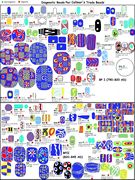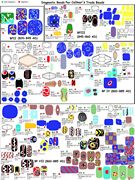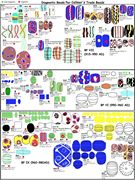A recently recovered artifact is all the buzz in the Norse re-enactor's community.
It is a three dimensional depiction of a woman, cast in silver. The bottom of the figure has been broken off (thought to be plow damage from working the field it was discovered in).
 |
| The Harby 'Valkyre' - click to see the published image size (!) |
(Metal) Detectorist Morten Skovsby found the ... figurine late last year at Hårby on Funen, (Central Denmark)
Go to the report
Pulling a couple of the starting comments from the Norsefolk2 discussion group:
On 09/01/2013 04:24, Hilde wrote:The first rush was divided into to main topics:
Hopefully, a high quality scan will be available some time in the future.
On Tue Jan 8, 2013 6:15 Charles wrote:
This is where the fun starts, now begins the search for archaeology to back up the outfit worn by the figure.
The need is there to make this more than an artistic representation.
1) Depiction of female with sword and shield - 'proof' of women in combat.
2) Deciphering details of the clothing.
There is a gap between the falling hair and the back of the neck. Much was being made of this : A pendant? Hung as a ritual object* ?
( Of course since the bottom of the dress line is broken, we can not tell if the piece was flat based to sit on a table, or might have once had details of the feet.)
But before we go too far - Look at another object from the Viking Age which has also been examined and argued about in minute detail:
'Odin fra Lejre '
by Tom Christensen
1,75 cm høj, 1,98 cm bred og 1,25 cm dyb,
(high / wide/ deep ?)
(images and quote from Christensen's report)
The
recent 'discussion' has centred around the sex of the figure. One camp
sees a female, based on the length of the garment and seeing the dotted
bands on the chest as four rows of beads. The other camp sees the figure
as male, based on the band around the mouth seen as a moustache, and
the iconography of the thrown of O∂in.
Now - a reality check. Take a look at this image:
 | |
| 'Warrior' - click for detail |
This is actually one of those 30 mm cast tin alloy miniatures so many of us used for war game / Dungeons & Dragons playing 'back in the day' (and still may do, for I know).
But before you start to attempt to determine all those fine details - Let's try something first:
All objects reduced to LIFE scale in these images.
It
has been my overwelming experience that no matter how much you work
with artifacts, you never really understand then until you see them in
life, actually before you. Reading the measurements does not really
impact you. Almost everything is either way SMALLER, or way LARGER in
actual truth, than what you imagine it is.
This is absolutely critical.
I have gotten into the habit now, for any object I have never actually seen
before me, to take the source image, scan / open it into Photoshop (or
the like). Then convert the image best as I can to the *actual* size
given for the object. I will often put a piece of blank graph paper into
my printer and print the life sized image on to that. This makes for
very easy conversions of details into physical measurements.
People
have been going a bit overboard (in my opinion, not so humble),
attempting to derive the finest detail from the published images of the
objects. Yes, it can be a wonderful tool to take a very high resolution
photograph, then look at that expanded version.
But what about the ancient artist who made the original object in the first place?
How small a thing was he really making?
What limits on detail were imposed by the medium he was working in?
Or by the tools he had available to work with?
Are you really looking at intended details of a reality?
Or is all this combined through an artistic style?
Let me
tell you, as someone who has actually worked with lost wax casting
techniques, there is very much a limit on just how much detail you can
physically place on any object that is as small as these pieces are!
* "Ritual Object'
Archaeological short hand for : 'We don't know what the heck this is for'
Cross Post from Darrell's own 'Hammered Out Bits'

























